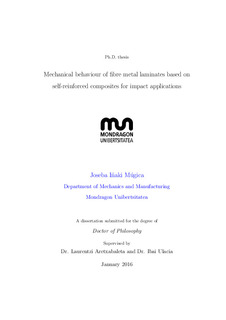
Ikusi/
Izenburua
Mechanical behaviour of fibre metal laminates based on self-reinforced composites for impact applicationsIrakurtze Data
2016-04-21Argitalpen data
2016Dokumentu-mota
Doktore tesiaDoktore tesiaHizkuntza
IngelesaEskubideak
© Joseba Iñaki Múgica AbarqueroSarbidea
Sarbide irekiaArgitaratzailearen bertsioa
https://doi.org/10.48764/6ghb-zk23Argitaratzailea
Mondragon Unibertsitatea. Goi Eskola PoliteknikoaGako-hitzak
Tecnología de materiales
Ingeniería y tecnología mecánicas
Ingeniería y tecnología aeronáuticas
ODS 9 Industria, innovación e infraestructura ... [+]
Ingeniería y tecnología mecánicas
Ingeniería y tecnología aeronáuticas
ODS 9 Industria, innovación e infraestructura ... [+]
Tecnología de materiales
Ingeniería y tecnología mecánicas
Ingeniería y tecnología aeronáuticas
ODS 9 Industria, innovación e infraestructura
ODS 13 Acción por el clima [-]
Ingeniería y tecnología mecánicas
Ingeniería y tecnología aeronáuticas
ODS 9 Industria, innovación e infraestructura
ODS 13 Acción por el clima [-]
Laburpena
Lightness and appropriate mechanical response of materials are currently demanded in many applications related to transportation (automotive, aeronautic). Depending on the component, an appropriate me ... [+]
Lightness and appropriate mechanical response of materials are currently demanded in many applications related to transportation (automotive, aeronautic). Depending on the component, an appropriate mechanical behaviour may consist in having either damage tolerance or energy dissipation capacity. In this regard, it is essential to understand the mechanical behaviour of the materials in order to succeed in the selection of them and the design of components.
Fibre metal laminates (FMLs) are multilayer systems consisting of stacked metal sheets and thin plates of composite material. Among FMLs, the ones based on self-reinforced composites (SRCs) have demonstrated they can offer an excellent response to low and high velocity impact loadings in terms of impact energy dissipating capacity when compared to thermosetting matrix-based systems.
The main objective of this thesis is to study the mechanical behaviour of fibre metal laminates based on SRCs. Within this general objective, three partial subobjectives are established:
- To select the most appropriate SRC-FML, between an Al-based one and a Mg-based one, in terms of energy dissipation capacity under low-velocity impacts.
- To characterise the mechanical behaviour of the plain SRC and to evaluate its influence in the mechanical response of the FML based on the strain rate.
- To develop a constitutive model of the mechanical behaviour of the SRC.
The results reveal that the Al/SRPP-FML is the most appropriate in terms of energy dissipation capacity under low-velocity impacts.
After that, the characterisation of the plain SRPP shows that, when the material is submitted to both tensile and shear stresses solicitations, it presents irreversible strains, hysteresis phenomena under cyclic loads, a rate-dependent behaviour and a stiffness varying with the strain. Besides, its influence in the mechanical response of the FML is considerable. Then, a constitutive model of the mechanical behaviour of the SRC is proposed. The model is based on the combination of a elastoplastic model and a fractional viscoelastic model.
The numerical-experimental correlation demonstrates that the model is capable of predicting accurately both the cyclic tensile and shear behaviours of the SRPP. [-]
Bildumak
- Tesiak - Ingeniaritza [243]




















